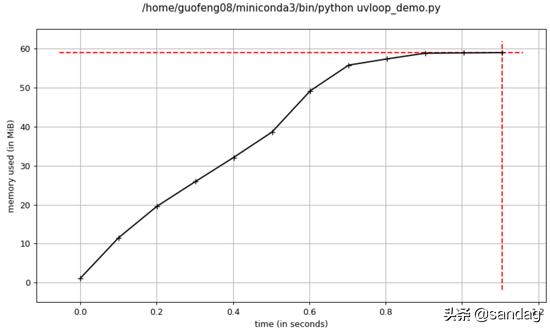IO 密集型应用IO 密集型应用CPU等待IO时间远大于CPU 自身运行时间,太浪费;常见的 IO 密集型业务包括:浏览器交互、磁盘请求、网络爬虫、数据库请求等

Python 世界对于 IO 密集型场景的并发提升有 3 种方法:多进程、 多线程 、异步 IO(asyncio);理论上讲asyncio是性能最高的,原因如下:
1.进程、 线程 会有CPU上下文切换
2.进程、线程需要内核态和用户态的交互,性能开销大;而协程对内核透明的,只在用户态运行
3.进程、线程并不可以无限创建,最佳实践一般是 CPU*2;而协程并发能力强,并发上限理论上取决于操作系统IO多路复用(Linux下是 epoll)可注册的文件描述符的极限
那asyncio的实际表现是否如理论上那么强,到底强多少呢?我构建了如下测试场景:
访问500台 DB,并sleep 100ms模拟业务查询 方法 1;顺序串行一台台执行 方法 2:多进程 方法 3:多线程 方法 4:asyncio 方法 5:asyncio+uvloop
最后的 asyncio+uvloop 和官方asyncio 最大不同是用 Cython+libuv 重新实现了asyncio 的事件循环(event loop)部分,官方测试性能是 node.js的 2 倍,持平 golang。
以下测试代码需要 Pyhton3.7+: 顺序串行一台台执行
#!/usr/bin/env python3
# -*- coding: utf-8 -*-
import records
user=xx
pass=xx
port=xx
hosts= [....] # 500台 db列表
def query(host):
conn = records.Database(
f' mysql +pymysql://{user}:{pass}@{host}:{port}/mysql?charset=utf8mb4')
rows = conn.query('select sleep(0.1);')
print(rows[0])
def main():
for h in hosts:
query(h)
# main entrance
if __name__ == '__main__':
main()
多进程
#!/usr/bin/env python3
# -*- coding: utf-8 -*-
from concurrent import futures
import records
user=xx
pass=xx
port=xx
hosts= [....] # 500台 db列表
def query(host):
conn = records.Database(
f'mysql+pymysql://{user}:{pass}@{host}:{port}/mysql?charset=utf8mb4')
rows = conn.query('select sleep(0.1);')
print(rows[0])
def main():
with futures.ProcessPoolExecutor() as executor:
for future in executor.map(query,hosts):
pass
# main entrance
if __name__ == '__main__':
main()
多线程
#!/usr/bin/env python3
# -*- coding: utf-8 -*-
from concurrent import futures
import records
user=xx
pass=xx
port=xx
hosts= [....] # 500台 db列表
def query(host):
conn = records.Database(
f'mysql+pymysql://{user}:{pass}@{host}:{port}/mysql?charset=utf8mb4')
rows = conn.query('select sleep(0.1);')
print(rows[0])
def main():
with futures.ThreadPoolExecutor() as executor:
for future in executor.map(query,hosts):
pass
# main entrance
if __name__ == '__main__':
main()
asyncio
#!/usr/bin/env python3
# -*- coding: utf-8 -*-
import asyncio
from databases import Database
user=xx
pass=xx
port=xx
hosts= [....] # 500台 db列表
async def query(host):
DATABASE_URL = f'mysql+pymysql://{user}:{pass}@{host}:{port}/mysql?charset=utf8mb4'
async with Database(DATABASE_URL) as database:
query = 'select sleep(0.1);'
rows = await database.fetch_all(query=query)
print(rows[0])
async def main():
tasks = [asyncio.create_task(query(host)) for host in hosts]
await asyncio.gather(*tasks)
# main entrance
if __name__ == '__main__':
asyncio.run(main())
asyncio+uvloop
#!/usr/bin/env python3
# -*- coding: utf-8 -*-
import asyncio
import uvloop
from databases import Database
user=xx
pass=xx
port=xx
hosts= [....] # 500台 db列表
async def query(host):
DATABASE_URL = f'mysql+pymysql://{user}:{pass}@{host}:{port}/mysql?charset=utf8mb4'
async with Database(DATABASE_URL) as database:
query = 'select sleep(0.1);'
rows = await database.fetch_all(query=query)
print(rows[0])
async def main():
tasks = [asyncio.create_task(query(host)) for host in hosts]
await asyncio.gather(*tasks)
# main entrance
if __name__ == '__main__':
uvloop.install()
asyncio.run(main())
运行时间对比
方式运行时间 串行1m7.745s多进程2.932s多线程4.813sasyncio1.068sasyncio+uvloop0.750s
可以看出: 无论多进程、多进程还是asyncio都能大幅提升IO 密集型场景下的并发,但asyncio+uvloop性能最高,运行时间只有原始串行运行时间的 1/90,相差快 2 个数量级了!
内存占用对比 串行

多进程

多线程

asyncio

asyncio+uvloop

可以看出 asyncio+uvloop 内存占用表现仍然最优,只有 60M;而多进程占用多达 1.4G,果然创建进程是个十分重的操作~
总结asyncio 无论运行时间还是内存占用都远优于多进程、多线程,配合 uvloop 性能还能进一步提升,在 IO 密集型业务中可以优先使用 asyncio。


